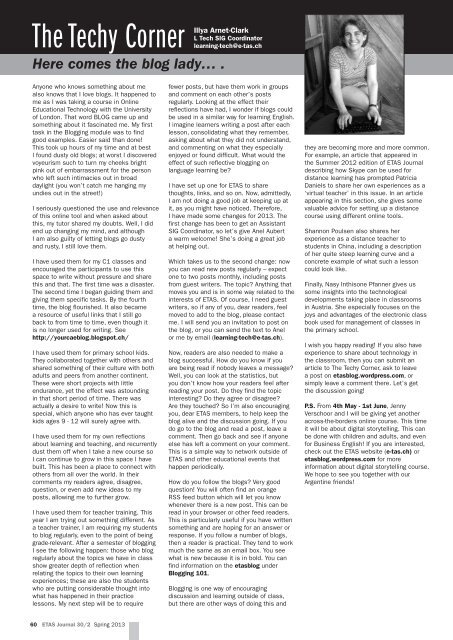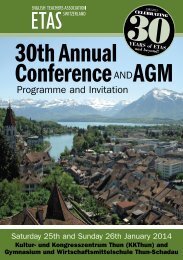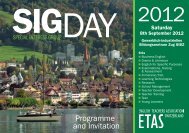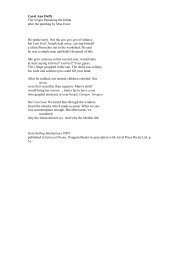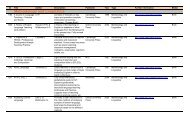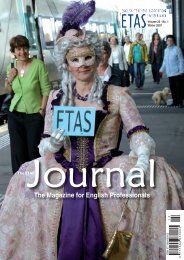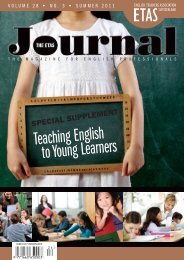InsightsOn Modern Linguistics and dialect studies:an interview with Dr David BritainDr David Britain has held the Chair <strong>of</strong>Modern <strong>English</strong> Linguistics at the University<strong>of</strong> Bern since January 2010 and is theco-author <strong>of</strong> Linguistics: an introduction (CUP,second edition, 2009). Prior to UNIBE, hewas a Senior Lecturer at the University <strong>of</strong>Essex in Colchester, England, where he alsoearned his PhD in Sociolinguistics. Dr Britaincompleted a Postdoc in New Zealand wherehe was part <strong>of</strong> a research team thatundertook the first large-scale social dialectanalysis <strong>of</strong> New Zealand <strong>English</strong>. Currently,Dr Britain is an Associate Editor <strong>of</strong> the<strong>Journal</strong> <strong>of</strong> Sociolinguistics, and is on theeditorial board <strong>of</strong> the <strong>Journal</strong> <strong>of</strong> LinguisticGeography, the International <strong>Journal</strong> <strong>of</strong><strong>English</strong> Studies, Babel, and the FrenchReview <strong>of</strong> <strong>English</strong> Linguistics.We are pleased and honoured to be able tointerview him for this issue.Julie: Let’s start <strong>of</strong>f with your work at theUniversity <strong>of</strong> Bern. What does the Chair <strong>of</strong>Modern <strong>English</strong> Linguistics do?Dave: My job has three main roles: (1) tocoordinate the Linguistics teaching in the<strong>English</strong> Department and, despite theLinguistics section being very small, toorganise a full and coherent studyprogramme right from the early years <strong>of</strong>the BA to the more specialist andresearch-oriented stages <strong>of</strong> the MA; (2)to conduct research in my field <strong>of</strong>specialisation, and support the scholars <strong>of</strong>the future to do so too, by supervising MAand PhD theses; (3) as a co-director <strong>of</strong> the<strong>English</strong> Department, to supervise andadminister the activities <strong>of</strong> the Departmentas a whole. From February 2011 to January<strong>2013</strong>, I was Head <strong>of</strong> Department.Julie: What is Modern <strong>English</strong> Linguistics?What does the term encompass?Dave: I like to think <strong>of</strong> Linguistics in arather broad sense as the study <strong>of</strong> language.Consequently it encompasses very manytopics. Most fundamentally it considers thebuilding blocks <strong>of</strong> the language – the soundsand how they are combined together; thewords; how these words are combined t<strong>of</strong>orm utterances; and how these utterancesare combined together to form discourse, sothe study <strong>of</strong> phonetics and phonology, lexis,morphology and syntax, and discourse.Additionally, it includes meaning and howthat meaning is applied in everyday talk.It includes how <strong>English</strong> has emerged andchanged over time and the many influencesfrom other languages that have shaped itover the years, as well as the influence ithas had on other languages. Important toois how <strong>English</strong> is acquired both by childrenand adults as well as the structure <strong>of</strong><strong>English</strong> used by people with a languagedisorder. For me, an especially importantpart <strong>of</strong> <strong>English</strong> Linguistics is looking at thedifferent <strong>English</strong>es spoken around the worldand thinking about how they got that way.And as a sociolinguist, I am also interestedin how people’s language use can bothmanifest as well as shape aspects <strong>of</strong> theirsocial identity. Also important is themechanics <strong>of</strong> conversation – for example,how we so seamlessly take turns whentalking, how and for what purpose wetell stories, how we begin and endconversations. And this is just a smallset <strong>of</strong> the topics that could be describedas <strong>English</strong> Linguistics.Julie: Can you describe your program at theUniversity <strong>of</strong> Bern?Dave: The BA in our Department is in<strong>English</strong> in general – Literature and CulturalStudies as well as Linguistics, and we aimhere to provide a solid foundation in thesetopics, whilst ensuring students gaintheoretical knowledge, analytical skills, anda breadth <strong>of</strong> exposure to work in these fieldsfrom different places and different timeperiods. I like to think <strong>of</strong> the MA, wherestudents can specialise in either Literatureor Linguistics, as a research orientationdegree – they gain advanced theoreticalinsights, but in addition learn in a muchmore hands-on way how to do linguisticsthemselves, how to collect relevant languagedata, how to analyse it, how then to dosomething with it. I place great emphasistherefore on courses which introducestudents to the joys and difficulties <strong>of</strong>fieldwork, as well as <strong>of</strong> language dataanalysis. So MA students with a Linguisticsmajor will get their hands dirty, doingLinguistics and not just reading about it.We also work with the Faculty’s Centerfor the Study <strong>of</strong> Language and Societywhich has an MA in Sociolinguistics. ThisMA brings together many linguists acrossthe faculty to produce a multilingual,interdisciplinary programme on languagein society.Julie: Who is the program for? How mightthe program benefit an <strong>English</strong> teacherin <strong>Switzerland</strong>?Dave: Most <strong>of</strong> our students are <strong>of</strong> courseat the BA level, and many <strong>of</strong> them want tobecome teachers <strong>of</strong> <strong>English</strong>. We’re veryconscious then <strong>of</strong> this special audienceand try to ensure that there are regularlinguistics courses which will be <strong>of</strong> specificinterest to future teachers – courses onsecond language acquisition, for example,or on bilingualism, as well as the basiccourses on the structure and mechanics<strong>of</strong> the language. At the MA level, students<strong>of</strong>ten examine these issues in more detail.I have supervised MA theses on theacquisition <strong>of</strong> specific parts <strong>of</strong> <strong>English</strong>grammar that are <strong>of</strong>ten said to be especiallyproblematic for Bernese students, such asthe past tense.Julie: Let’s talk a little about your researchinterests. One common theme connectsdialect variation and mobility. Why is thisimportant? What are some implications?Dave: A lot <strong>of</strong> the dialect research inAnglophone countries has explicitly avoidedmobile people or mobile communities.The first dialect studies in Britain, forexample, deliberately sought out ‘NORMs’(‘Non-mobile Old Rural Men’) because itwas thought they spoke the purest dialect,least influenced by external influences.When sociolinguistic approaches todialectology arrived in the 1960s, the study<strong>of</strong> dialect moved to some <strong>of</strong> the largestcities in the world, but again mobile people,people not brought up in that community,were still shunned. In the past 20 yearsor so we’ve been learning that mobilepeople are in fact extremely influentialtriggers <strong>of</strong> language and dialect change incommunities, so we can’t really adequatelyinvestigate dialect change withoutconsidering them. My early research beganby looking at dialects that had been formedby acts <strong>of</strong> migration – in England, and thenlater in New Zealand. More recently I’vebeen interested in the more mundane andeveryday mobilities (e.g. commuting) andhow they can affect dialect. Given its effecton language change, and given that we areliving in an increasingly mobile world, I don’tthink we can adequately study dialect andignore the effects <strong>of</strong> mobility. I also think itwould be fascinating to see if there are anydifferences in the nature <strong>of</strong> our dialectswhen we are talking on the phone, or, forexample, talking to passengers while drivinga car, contexts where normal face-to-faceinteraction is disrupted in some way. Inthese contexts the speakers are either notdirectly looking at each other (and so can’tuse facial expression and gesture in thesame way) or are not even in the sameplace as each other at all. I’m surprisedthat very little research has examined this.Julie: In 2009 you co-edited a special issue<strong>of</strong> the International <strong>Journal</strong> <strong>of</strong> the Sociology<strong>of</strong> Language on dialect death in Europe.Can you share some highlights or insightswith us?56 ETAS <strong>Journal</strong> 30/2 <strong>Spring</strong> <strong>2013</strong>
The Techy CornerHere comes the blog lady… .Illya Arnet-ClarkL Tech SIG Coordinatorlearning-tech@e-tas.chAnyone who knows something about mealso knows that I love blogs. It happened tome as I was taking a course in OnlineEducational Technology with the University<strong>of</strong> London. That word BLOG came up andsomething about it fascinated me. My firsttask in the Blogging module was to findgood examples. Easier said than done!This took up hours <strong>of</strong> my time and at bestI found dusty old blogs; at worst I discoveredvoyeurism such to turn my cheeks brightpink out <strong>of</strong> embarrassment for the personwho left such intimacies out in broaddaylight (you won’t catch me hanging myundies out in the street!)I seriously questioned the use and relevance<strong>of</strong> this online tool and when asked aboutthis, my tutor shared my doubts. Well, I didend up changing my mind, and althoughI am also guilty <strong>of</strong> letting blogs go dustyand rusty, I still love them.I have used them for my C1 classes andencouraged the participants to use thisspace to write without pressure and sharethis and that. The first time was a disaster.The second time I began guiding them andgiving them specific tasks. By the fourthtime, the blog flourished. It also becamea resource <strong>of</strong> useful links that I still goback to from time to time, even though itis no longer used for writing. Seehttp://yourcaeblog.blogspot.ch/I have used them for primary school kids.They collaborated together with others andshared something <strong>of</strong> their culture with bothadults and peers from another continent.These were short projects with littleendurance, yet the effect was astoundingin that short period <strong>of</strong> time. There wasactually a desire to write! Now this isspecial, which anyone who has ever taughtkids ages 9 - 12 will surely agree with.I have used them for my own reflectionsabout learning and teaching, and recurrentlydust them <strong>of</strong>f when I take a new course soI can continue to grow in this space I havebuilt. This has been a place to connect withothers from all over the world. In theircomments my readers agree, disagree,question, or even add new ideas to myposts, allowing me to further grow.I have used them for teacher training. Thisyear I am trying out something different. Asa teacher trainer, I am requiring my studentsto blog regularly, even to the point <strong>of</strong> beinggrade-relevant. After a semester <strong>of</strong> bloggingI see the following happen: those who blogregularly about the topics we have in classshow greater depth <strong>of</strong> reflection whenrelating the topics to their own learningexperiences; these are also the studentswho are putting considerable thought intowhat has happened in their practicelessons. My next step will be to requirefewer posts, but have them work in groupsand comment on each other’s postsregularly. Looking at the effect theirreflections have had, I wonder if blogs couldbe used in a similar way for learning <strong>English</strong>.I imagine learners writing a post after eachlesson, consolidating what they remember,asking about what they did not understand,and commenting on what they especiallyenjoyed or found difficult. What would theeffect <strong>of</strong> such reflective blogging onlanguage learning be?I have set up one for ETAS to sharethoughts, links, and so on. Now, admittedly,I am not doing a good job at keeping up atit, as you might have noticed. Therefore,I have made some changes for <strong>2013</strong>. Thefirst change has been to get an AssistantSIG Coordinator, so let’s give Anel Auberta warm welcome! She’s doing a great jobat helping out.Which takes us to the second change: nowyou can read new posts regularly – expectone to two posts monthly, including postsfrom guest writers. The topic? Anything thatmoves you and is in some way related to theinterests <strong>of</strong> ETAS. Of course, I need guestwriters, so if any <strong>of</strong> you, dear readers, feelmoved to add to the blog, please contactme. I will send you an invitation to post onthe blog, or you can send the text to Anelor me by email (learning-tech@e-tas.ch).Now, readers are also needed to make ablog successful. How do you know if youare being read if nobody leaves a message?Well, you can look at the statistics, butyou don’t know how your readers feel afterreading your post. Do they find the topicinteresting? Do they agree or disagree?Are they touched? So I’m also encouragingyou, dear ETAS members, to help keep theblog alive and the discussion going. If youdo go to the blog and read a post, leave acomment. Then go back and see if anyoneelse has left a comment on your comment.This is a simple way to network outside <strong>of</strong>ETAS and other educational events thathappen periodically.How do you follow the blogs? Very goodquestion! You will <strong>of</strong>ten find an orangeRSS feed button which will let you knowwhenever there is a new post. This can beread in your browser or other feed readers.This is particularly useful if you have writtensomething and are hoping for an answer orresponse. If you follow a number <strong>of</strong> blogs,then a reader is practical. They tend to workmuch the same as an email box. You seewhat is new because it is in bold. You canfind information on the etasblog underBlogging 101.Blogging is one way <strong>of</strong> encouragingdiscussion and learning outside <strong>of</strong> class,but there are other ways <strong>of</strong> doing this andthey are becoming more and more common.For example, an article that appeared inthe Summer 2012 edition <strong>of</strong> ETAS <strong>Journal</strong>describing how Skype can be used fordistance learning has prompted PatriciaDaniels to share her own experiences as a‘virtual teacher’ in this issue. In an articleappearing in this section, she gives somevaluable advice for setting up a distancecourse using different online tools.Shannon Poulsen also shares herexperience as a distance teacher tostudents in China, including a description<strong>of</strong> her quite steep learning curve and aconcrete example <strong>of</strong> what such a lessoncould look like.Finally, Nasy Inthisone Pfanner gives ussome insights into the technologicaldevelopments taking place in classroomsin Austria. She especially focuses on thejoys and advantages <strong>of</strong> the electronic classbook used for management <strong>of</strong> classes inthe primary school.I wish you happy reading! If you also haveexperience to share about technology inthe classroom, then you can submit anarticle to The Techy Corner, ask to leavea post on etasblog.wordpress.com, orsimply leave a comment there. Let’s getthe discussion going!P.S. From 4th May - 1st June, JennyVerschoor and I will be giving yet anotheracross-the-borders online course. This timeit will be about digital storytelling. This canbe done with children and adults, and evenfor Business <strong>English</strong>! If you are interested,check out the ETAS website (e-tas.ch) oretasblog.wordpress.com for moreinformation about digital storytelling course.We hope to see you together with ourArgentine friends!60 ETAS <strong>Journal</strong> 30/2 <strong>Spring</strong> <strong>2013</strong>


